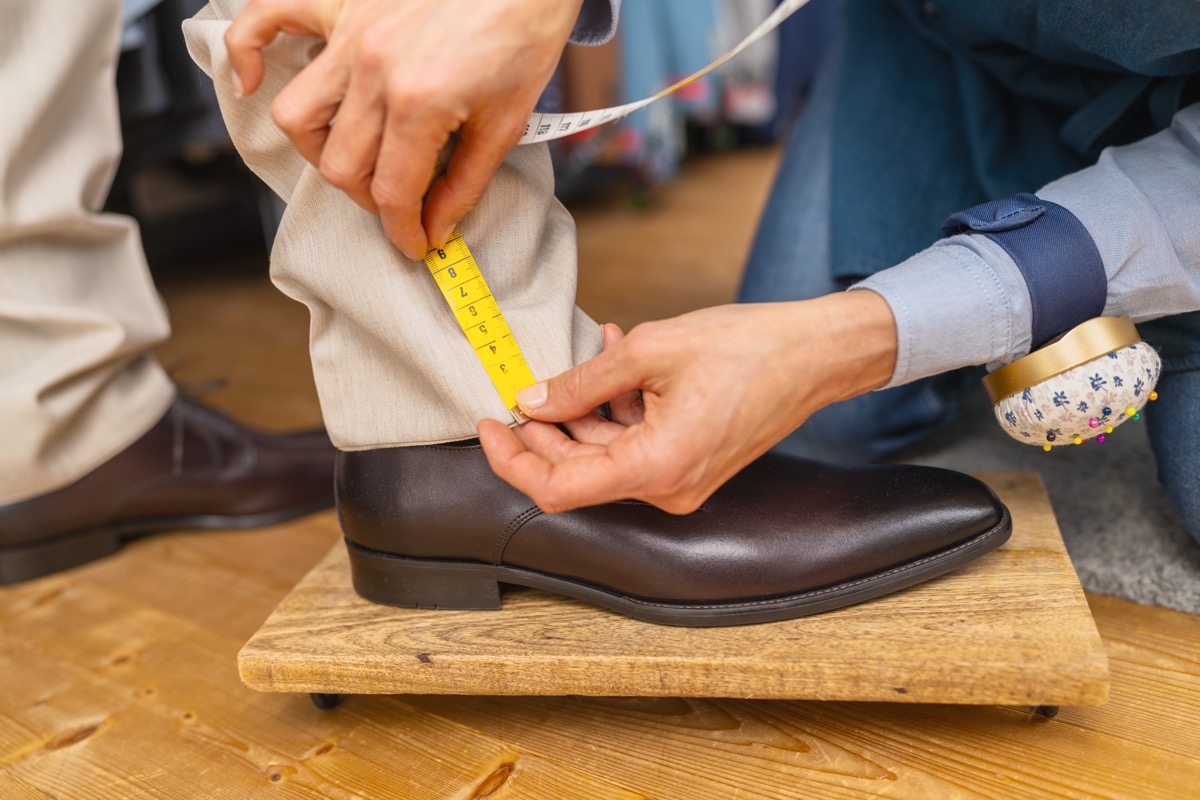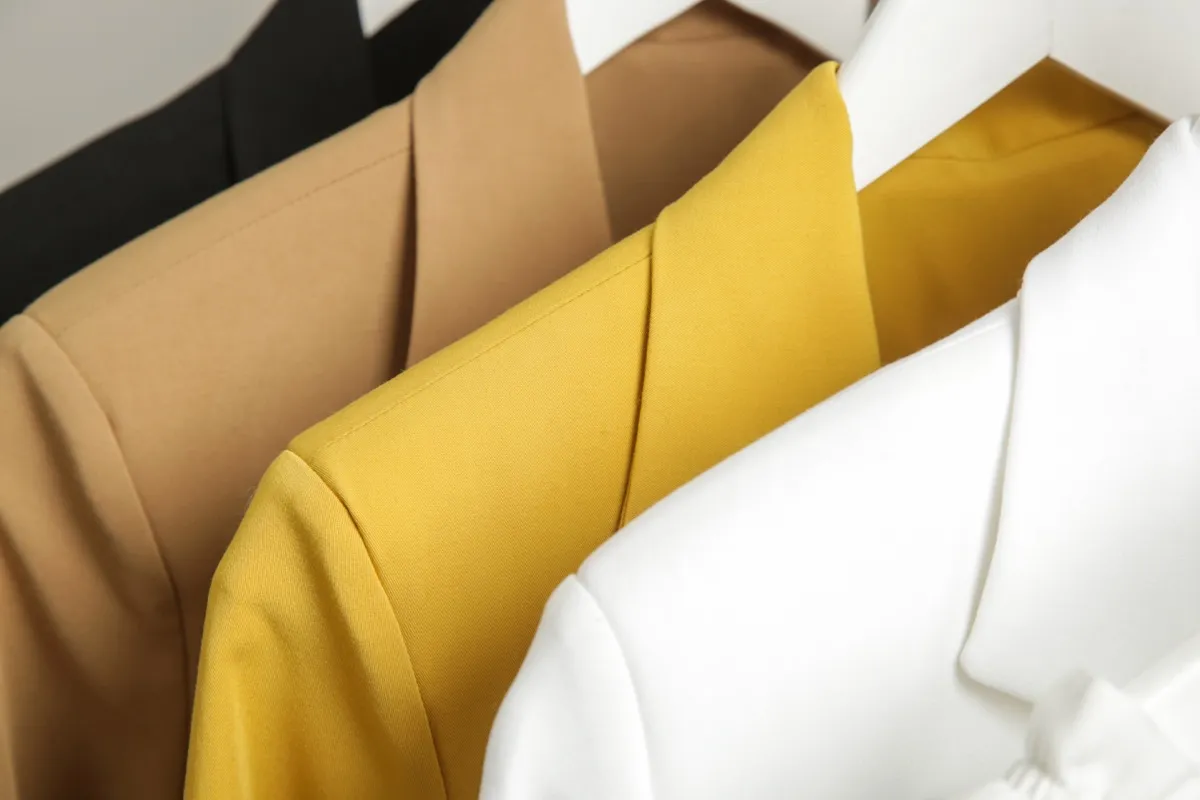
Getting a flawless fit in clothing bought off the racks is a dream that doesn’t happen often—especially if you’re between sizes or have some height advantages or disadvantages. When that’s the case, a good tailor can alter your new clothes and turn ill-fitting and unflattering silhouettes into polished pieces that fit you like a glove. A skilled tailor can transform everyday clothing into custom-fitted garments that can help you exude confidence, comfort, and style. They can elevate the look of a bespoke suit or formal gown for your next big event. But, before making an appointment with a local tailor in your area, here are some crucial things you need to know in order to have a great experience.
RELATED: 10 Signs You Need to Get Your Clothing Tailored.
How to Find a Great Tailor in Your Area
Tailoring is an art form, and finding a talented professional is half the battle. “Not all tailors are created equal,” admits Maria Murphy, designer and founder of Sarsparilly. a vintage clothing site for women. “For some, the skill level is off the charts and they can make you look a million dollars in your outfit. Others are great at hemming pants and skirts, but you wouldn’t trust them with your wedding dress.”
Typically, the best way to find a great tailor in your area is through word of mouth and referrals since you can hear first-hand experiences. But, if that doesn’t pan out, read reviews and do your research online.
“Look at their work before allowing them to work on a garment for you,” suggests Jennifer Love, CEO and founder of Bodylicious Couture, a couture line of women’s wear. “This will save you time and money and prevent you from getting horrible pieces.”
1. Plan Your Budget

The first thing you should know is that tailoring isn’t cheap—especially for pieces like a wedding dress or suit. So, it’s important to establish what kind of budget you’re working with before you go to a tailor’s shop.
“Tailoring can vary significantly in cost, and knowing your budget can help you select appropriate options,” says Sonny Grant with Grant & O’Sullivan Tailors. You can communicate your desired spend with your tailor in order to compromise on a solution that works for both of you.
2. Bring the Proper Shoes


For a tailor to do their job correctly, you need to do yours by bringing the proper shoes that you plan to wear with said outfit. This goes for everyone, regardless of your gender.
“When hemming pants, depending on the style, fit, and heel of the shoes, your pants need to be hemmed differently for different types of shoes,” explains Sarene Alsharif, LDN, MPH, CEO and co-founder of Tad More Tailoring and Alterations. The same applies if you’re looking to alter a dress or skirt.
RELATED: 10 Timeless Clothing Items That Never Go Out of Style.
3. Know What Undergarments You’ll Need


Another important item you’ll need to bring with you to the tailor is the undergarment(s) you plan to wear with the look.
For instance, if you’re having a wedding dress altered, bring the shapewear you plan to rock that day.
“If you’re wearing a bra, is it a padded bra to give a lift or a sports bra to keep things close and tight?” says Alsharif. “If your dress is fitted to you in one bra or without a bra and then you change your mind, the bust of the dress will not fit properly.”
4. Show Your Tailor Some Inspiration Pics


To ensure you get exactly the kind of look you’re going for, Alsharif recommends showing the tailor photos of your vision.
“If you are recreating or doing a lot of extensive changes, know what you want done and have inspirational pictures,” she says. “Show those pictures to your tailor; this will help them understand your vision and help you create the look and the fit you want.”
RELATED: 5 Clothing Patterns That Make You Look Older, Stylists Say.
5. Consider the Occasion


According to Nguyen Huy, a fashion stylist and founder of apparel site Trendy Aloha, knowing the event you’re wearing the garment to is important information to share with your tailor.
“Tailoring for a business meeting differs from tailoring for a wedding, so conveying the occasion to your tailor can make a big difference in the final look.”
6. Get Familiar With Different Kinds of Fabric


Fabric choice can significantly impact the quality, look, and feel of clothing, and according to Grant, you must understand these basics in order to make communication with your tailor easier. For instance, if you bring in a wool piece, you should know that it won’t have the same stretch as, say, a polyester garment—so you can’t expect miracles.
“Familiarize yourself with different fabric types and their qualities. This ensures you make informed choices that match your style and comfort preferences,” Grant says.
7. Be Ready for Multiple Fittings


Finally, in most cases, the tailoring process isn’t a quick one-and-done visit. Before you make your first appointment, make sure you can accommodate follow-up visits.
“Tailoring is a process that may require multiple fittings to achieve perfection,” Huy explains. “I always tell people to be prepared for this so they won’t be frustrated if the first fitting isn’t perfect.”



